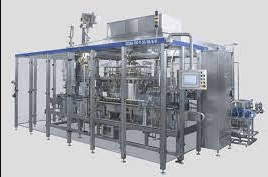What’s the Best Kind of Filling Machine? A Comprehensive Guide
In the fast-paced world of manufacturing and production, efficiency and precision are key. One critical aspect that plays a pivotal role in various industries is the filling machine. Whether you’re in the food and beverage, pharmaceutical, or cosmetics industry, selecting the right filling machine can significantly impact your operations. In this article, we’ll dive deep into the different types of filling machines, their advantages, and how to choose the best one for your specific needs.
Introduction
Single Head Filling Machines play a crucial role, i.e., manufacturing by efficiently and accurately packaging products into containers. With various options available, choosing the right type of filling machine can be daunting. In this article, we’ll break down the different types of filling machines and provide insights into selecting the best one for your specific requirements.
The Importance of Filling Machines
Filling machines are the backbone of many industries, ensuring products are packaged with precision, reducing wastage, and maintaining product consistency. From liquids to powders, these machines streamline the packaging process, leading to increased productivity and reduced labor costs.
Types of Filling Machines
3.1. Gravity Fillers
Gravity fillers rely on, as the name suggests, the force of gravity to fill containers. They are ideal for free-flowing liquids and are widely used in the beverage industry.
3.2. Piston Fillers
Piston fillers utilize a piston and cylinder mechanism to accurately measure and fill products. They are suitable for a wide range of viscosities and are often found in the pharmaceutical and cosmetic industries.
3.3. Overflow Fillers
Overflow fillers are commonly used for filling liquids into containers with a consistent level. They are precise and prevent overfilling, making them popular in the cosmetics and chemical industries.
3.4. Auger Fillers
Auger fillers are designed for filling powdery substances. They use a rotating auger to dispense a controlled amount of product, ensuring accuracy and minimizing dust.
3.5. Volumetric Cup Fillers
Volumetric cup fillers use specially designed cups to measure and dispense products. They are versatile and can handle a wide range of product types, from granules to small parts.
Factors to Consider When Choosing a Filling Machine
4.1. Nature of the Product
The type of product you’re filling plays a significant role in selecting the right filling machine. Liquids, creams, powders, and solids each have specific requirements that certain types of fillers can accommodate.
4.2. Production Volume
Consider your production volume when choosing a filling machine. High-volume production may require automated fillers, while lower volume production might benefit from manual fillers.
4.3. Filling Accuracy
Different products demand different levels of filling accuracy. For pharmaceuticals and chemicals, precision is critical, while other products may have more lenient tolerances.
4.4. Container Type and Size
The size, shape, and material of your containers impact the type of filling machine you need. Ensure compatibility to avoid bottlenecks and errors.
4.5. Cost and Budget
Filling machines vary in cost, so establish a budget and assess the long-term return on investment. Consider maintenance, operation, and potential downtime costs.
Advantages of Automated Filling Machines
Automated filling machines offer numerous benefits, including increased efficiency, reduced labor costs, and higher filling accuracy. They can integrate into existing production lines and often come with advanced features like digital controls and data logging.
Manual vs. Automatic Filling Machines
6.1. Pros and Cons of Manual Fillers
Manual fillers are cost-effective, simple to operate, and suitable for small-scale production. However, they are slower, less accurate, and require more labor.
6.2. Pros and Cons of Automatic Fillers
Automatic fillers are highly efficient, accurate, and suitable for large-scale production. Yet, they are more expensive upfront and may require specialized training for operation and maintenance.
Maintenance and Care of Filling Machines
7.1. Regular Cleaning and Inspection
Proper maintenance starts with regular cleaning and inspection. Keep the machine and its components clean to prevent contamination and ensure consistent performance.
7.2. Lubrication and Wear Parts Replacement
Lubricate moving parts as per the manufacturer’s guidelines to reduce friction and wear. Replace worn-out parts promptly to avoid disruptions in production.
7.3. Troubleshooting Common Issues
Train your staff to identify and address common issues such as leaks, inaccurate filling, or misalignments. Quick troubleshooting can minimize downtime.
Future Trends in Filling Machine Technology
As technology advances, filling machines continue to evolve. Expect to see improvements in automation, IoT integration, and data analytics, enhancing efficiency and accuracy.
Conclusion
Selecting the best Single Head Filling Machines for your needs requires careful consideration of factors such as product type, production volume, accuracy requirements, and budget constraints. Whether you opt for manual or automatic, maintaining your filling machine is essential for consistent performance and longevity. Stay abreast of technological advancements to make informed choices that drive productivity and growth.
FAQs
- Q: What industries benefit most from gravity fillers?
- A: Gravity fillers are commonly used in the beverage and oil industries for their ability to handle free-flowing liquids.
- Q: Are piston fillers suitable for high-viscosity products?
- A: Yes, piston fillers are excellent for accurately filling high-viscosity products like creams and lotions.
- Q: Can overflow fillers handle foamy liquids?
- A: Overflow fillers are designed to handle foamy liquids by maintaining a consistent fill level.
- Q: Are automated fillers customizable for unique production needs?
- A: Yes, automated fillers can often be customized to accommodate specific product and production line requirements.
- Q: How do I stay updated on the latest filling machine technology trends?
- A: Regularly follow industry publications, attend trade shows, and engage with manufacturers to stay informed about technological advancements.
